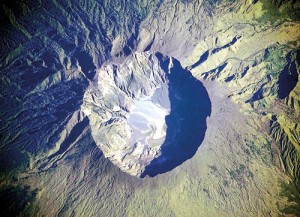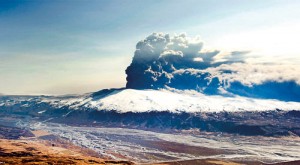Sunday Times 2
Will a volcanic eruption destroy humanity?
The world is woefully unprepared for a massive volcanic eruption that could kill millions of people and destroy much of modern society, a leading group of scientists have warned. In a new report on the risks posed by natural disasters, experts at the European Science Foundation concluded that large volcanic eruptions posed the greatest risk human survival. They calculated that there is between a five to 10 per cent probability of an explosive eruption large enough to cause huge numbers of deaths, alter the climate and poison the atmosphere occurring by the end of the century.
Such an eruption would be of a similar size to the explosion of Tambora on Sumbawa, Indonesia in 1815, which killed around 100,000 people at the time. The ash cloud thrown out from this eruption reached more than 26 miles (43km) into the atmosphere and triggered temperature changes that led to widespread famine and epidemics. The summer following the Tambora eruption is known as ‘the year without summer’.

The remains of the Tambora volcano in Sumbawa, Indonesia (above) triggered global changes in climate (NASA)
The scientists warn, however, that rising population levels and increasing reliance on global travel could mean the impacts of a similar eruption could be far more severe. Writing in their report Extreme Geohazards: Reducing the Disaster Risk and Increasing Resilience, the experts warn that there needs to be an international response to prepare for such a disaster and to monitor for similar events. They estimate that it could cost between £340 million ($500 million) and £2.3 billion ($3.5 billion) a year to increase the level of monitoring for catastrophic volcanic eruptions, but the benefits that an early warning could give would ten to hundreds of times greater. The report states: ‘Although in the last few decades earthquakes have been the main cause of fatalities and damage, the main global risk is large volcanic eruptions that are less frequent but far more impactful than the largest earthquakes. ‘Due to their far-reaching effects on climate, food security, transportation, and supply chains, these events have the potential to trigger global disaster and catastrophe. ‘The cost of response and the ability to respond to these events is beyond the financial and political capabilities of any individual country. ‘An international geopolitical response will be required, where science has a unique and key role in preparation, response and mitigation.’ The report, which was presented at the general assembly of the European Geosciences Union in Vienna on Tuesday, examines the main geohazards facing the world including earthquakes, drought, asteroid strikes, floods, tsunamis, hurricanes, avalanches and wildfires. It said that large to extreme earthquakes and tsunamis had been more common in the past 2000 years and this had focused the world’s disaster response resources onto this threat. But it concluded that the risk posed by volcanic eruptions is potentially far more serious. Pointing to recent eruptions like the Icelandic volcano Eyjafjallajokull, which caused widespread disruption when it threw clouds of ash into the atmosphere. It created the highest level of air travel disruption in Europe since the second world war and cost the European economy around $5 billion. However, the researchers said that this eruption was relatively minor – rating between three and four on the Volcanic Explosivity Index (VEI). By comparison, the volcanic eruption in 79AD of Mount Vesuvius that destroyed Pompeii in Italy was around VEI5.

The eruption of Eyjafjallajokull (above) in 2010 caused widespread air traffic disruption but was relatively minor. This aerial photo shows the Eyjafjallajokull volcano billowing smoke and ash on April 17, 2010 s(AFP)
Mount St Helen’s explosion in 1980 was also VEI5. The report states that there has been around 20 eruptions greater than VEI5 since 1500 with only the Tambora eruption reaching VEI7. However around 75,000 years ago the explosion of a supervolcano at the site of Lake Toba on Sumatra in Indonesia was one of the world’s largest known eruptions – rated VEI8. It caused a global volcanic winter that lasted around 10 years and has been linked to 1,000 years of cooling. There is also some evidence that suggests around this time human populations fell to some of their lowest levels ever, clinging on in just a few isolated groups. The report says that eruptions on this scale occur between once every 45,000 years to once every 714,000 years, but such an eruption could kill up to a tenth of the world’s population. ‘Events on the scale of the Toba eruption 74,000 years ago could return humanity to a pre-civilisation state,’ warned the scientists. ‘Volcanic eruptions can have more severe impacts through atmospheric and climate effects and can lead to drastic problems in food and water security, as emphasised by the widespread famine and diseases that were rampant after the Laki 1783 and Tambora 1815 eruptions. ‘Hence extreme volcanic eruptions pose a higher associated risk than all other natural hazards with similar recurrence periods, including asteroid impacts.’
The experts also warned that even smaller eruptions, similar to the Laki eruption in Iceland in 1783, could have global impacts. While the eruption caused 9,350 deaths in Iceland, the eight month emission of sulfuric aerosols, ash and other gases caused ‘one of the most important climatic and socially repercussive events of the last millennium’. In Iceland an estimated 20-25% of the population died in the famine and from fluorine poisoning after the fissure eruptions ceased. The resulting famine that afflicted Egypt in 1784 caused nearly one sixth of the country’s population to die out. In Britain the summer of 1783 was known as the ‘sand summer’ because of the ash fallout and an estimated 25,000 people died due to breathing problems. The scientists wrote: ‘Why are we not prepared for extreme events? Reasons for this include the low perceived likelihood of such an event, low political sensitivity, and a disconnect between scientific communities and decision-makers. ‘Reasons for the lack of socially acceptable strategies include the cost of preparing for an extreme hazard, and, in some cases, the belief that consequences are so extreme that preparedness is futile.’ They added that world leaders now need to spend up to £2 billion a year on a global network to monitor volcanic activity as even a few weeks of early warning could be crucial. ‘Threats from low-frequency, high impact events are grossly underestimated in disaster risk reduction. This is particularly true for volcanic eruptions. ‘During the Holocene, at least seven VEI 7 eruptions took place. All but one occurred at a time when the global population was far below 1 billion. ‘With a population above 7 billion and heading for 12 billion, a recurrence of a VEI 7 eruption could have extreme consequences.’ © Daily Mail, London

